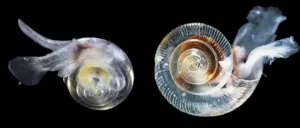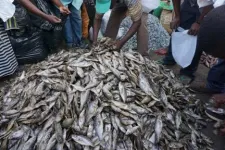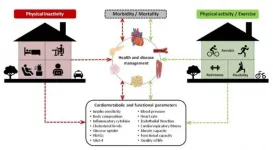Loss of smell is the best sign of COVID-19
Two international studies confirm that for the majority of patients with respiratory infections who lose the sense of smell, this is due to COVID-19. The disease also often results in both loss of taste and the other senses in the mouth.
2021-01-19
(Press-News.org) Two international studies confirm that for the majority of patients with respiratory infections who lose the sense of smell, this is due to COVID-19. The disease also often results in both loss of taste and the other senses in the mouth. A researcher from Aarhus University has contributed to the new results.
If you have had COVID-19, then forget about enjoying the smell of freshly made coffee. At any rate, two major international studies document that there is frequently a loss of smell and that this often lasts for a long time in cases of COVID-19
Alexander Wieck Fjaeldstad, is associate professor in olfaction and gustation at Aarhus University, and is behind the Danish part of the study.
The study shows that the average loss of the sense of smell was 79.7 on a scale from 0-100 - which indicates a large to complete sensory loss, says the researcher. In addition, the studies show that the loss of smell is very probably the best predictor of COVID-19 among patients with symptoms of respiratory diseases.
"This emphasises how important it is to be aware of this symptom, as it may be the only symptom of the disease," says Alexander Wieck Fjaeldstad, who also stresses only around half of patients with a loss of smell have gotten their sense of smell back after forty days.
"This differs from the picture we see with other viral infections and causes long-term discomfort for patients, both in relation to food and social contact, while at the same time causing them worry."
In addition to the loss of the sense of smell, the sense of taste was also significantly reduced, to 69.0 on a scale from 0-100, just as the remaining sense of feeling in the mouth was also reduced, this time to 37.3 on a scale from 0-100.
"While the loss of smell in itself removes the ability to sense the aroma of food, the simultaneous loss of the other senses make it difficult to register what you're eating. Putting food in your mouth can therefore become a decidedly unpleasant experience," explains Alexander Wieck Fjaeldstad.
A total of 23 nationalities and over 4,500 COVID-19 patients from all over the world have responded to the researchers' questionnaire.
"The study is of interest both to patients suffering sensory loss as well as clinicians and researchers who work with diagnostics and following-up on COVID-19. It shows that the loss of smell is specific to COVID-19, which is both relevant in relation to recognising the infection, and because it indicates that the sense of smell is closely linked to how SARS-CoV-2 infects the body."
Previously, researchers have based the correlation between COVID-19 and the loss of the chemical senses on smaller studies, while these studies collect large amounts of data from countries all over the world.
"The collaboration on the projects also entails a dialogue between researchers from all over the world, which makes it possible to share knowledge and ideas in order to promote the research field," says Alexander Wieck Fjaeldstad and continues: "The results are in line with our own national studies and pave the way for future studies on risk factors for permanent sensory loss, along with a better understanding of the consequences of these sensory losses for the patients. Among the aspects being studied are which factors are associated with a milder or briefer loss of the sense of smell and how this loss is associated with the rest of the course of the disease. The collection of data is continuing and will result in additional publications with even more participants."
INFORMATION:
The results have been published in the scientific journal Chemical Senses.
Background for the results
The studies are based on a survey translated into 23 languages and answered by more than 4,500 people infected with Covid-19.
The studies have been carried out in collaboration with the Global Consortium for Chemosensory Research.
Funded by James and Helen Zallie.
The scientific articles can be read in Chemical Senses: https://pubmed.ncbi.nlm.nih.gov/33367502/ and https://pubmed.ncbi.nlm.nih.gov/32564071/
Contact
Alexander Wieck Fjældstad
Department of Clinical Medicine
alefja@clin.au.dk
ELSE PRESS RELEASES FROM THIS DATE:
2021-01-19
In a large-scale study of Danish children and young people, researchers from Aarhus University have for the first time found genetic variants that increase the risk of nocturnal enuresis - commonly known as bedwetting or nighttime incontinence. The findings provide completely new insights into the processes in the body causing this widespread phenomenon.
Researchers have long known that nighttime incontinence is a highly heritable condition. Children who wet the bed at night often have siblings or parents who either suffer from or have suffered from the same condition. ...
2021-01-19
Shelled pteropods, microscopic free-swimming sea snails, are widely regarded as indicators for ocean acidification because research has shown that their fragile shells are vulnerable to increasing ocean acidity.
A new study, published in the journal Scientific Reports, shows that pteropods sampled off the coasts of Washington and Oregon made thinner shells than those in offshore waters. Along the coast, upwelling from deeper water layers brings cold, carbon dioxide-rich waters of relatively low pH to the surface. The research, by a team of Dutch and American scientists, ...
2021-01-19
Scientists at the U.S. Department of Energy's Ames Laboratory and collaborators at Brookhaven National Laboratory and the University of Alabama at Birmingham have discovered a new light-induced switch that twists the crystal lattice of the material, switching on a giant electron current that appears to be nearly dissipationless. The discovery was made in a category of topological materials that holds great promise for spintronics, topological effect transistors, and quantum computing.
Weyl and Dirac semimetals can host exotic, nearly dissipationless, electron conduction properties that take advantage of the unique state in the crystal lattice and electronic structure of the material that protects the electrons from doing so. These anomalous electron transport channels, ...
2021-01-19
Scientists have shown that two species of seasonal human coronavirus related to SARS-CoV-2 can evolve in certain proteins to escape recognition by the immune system, according to a study published today in eLife.
The findings suggest that, if SARS-CoV-2 evolves in the same way, current vaccines against the virus may become outdated, requiring new ones to be made to match future strains.
When a person is infected by a virus or vaccinated against it, immune cells in their body will produce antibodies that can recognise and bind to unique proteins on the virus' surface known as antigens. The immune system relies on being able to 'remember' the antigens that relate to a specific virus in order to provide immunity against it. However, in some viruses, such as ...
2021-01-19
DENVER--A study in the Journal of Thoracic Oncology (JTO) comparing surgeries performed at one Chinese hospital in 2019 with a similar date range during the COVID-19 pandemic found that routine thoracic surgery and invasive examinations were performed safely. The JTO is the official journal of the International Association for the Study of Lung Cancer.
Wentao Fang, MD, chief director of the Department of Thoracic Surgery, Shanghai Chest Hospital, Shanghai Jiao Tong University, Shanghai, China and his colleagues analyzed the number of elective procedures ...
2021-01-19
Scientists are urging global policymakers and funders to think of fish as a solution to food insecurity and malnutrition, and not just as a natural resource that provides income and livelihoods, in a newly-published paper in the peer-reviewed journal Ambio. Titled "Recognize fish as food in policy discourse and development funding," the paper argues for viewing fish from a food systems perspective to broaden the conversation on food and nutrition security and equity, especially as global food systems will face increasing threats from climate change.
The "Fish as Food" paper, authored by scientists and policy experts from Michigan State University, Duke ...
2021-01-19
HOUSTON - (Jan. 19, 2021) - Microscopic bubbles can tell stories about Earth's biggest volcanic eruptions and geoscientists from Rice University and the University of Texas at Austin have discovered some of those stories are written in nanoparticles.
In an open-access study published online in Nature Communications, Rice's Sahand Hajimirza and Helge Gonnermann and UT Austin's James Gardner answered a longstanding question about explosive volcanic eruptions like the ones at Mount St. Helens in 1980, the Philippines' Mount Pinatubo in 1991 or Chile's Mount Chaitén in 2008.
Geoscientists have long sought to use tiny bubbles in erupted lava and ash to reconstruct some of the conditions, ...
2021-01-19
Social distancing and working from home help prevent transmission of the novel coronavirus but can be conducive to unhealthy behavior such as bingeing on fast food or spending more time in a chair or on a couch staring at a screen, and generally moving about less during the day. Scientists believe the reduction in physical activity experienced during the first few months of the pandemic could lead to an annual increase of more than 11.1 million in new cases of type 2 diabetes and result in more than 1.7 million deaths.
The estimates are presented by researchers at São Paulo State University (UNESP), Brazil, in a review article published in Frontiers in Endocrinology. The authors stress that there is an "urgent need" to recommend physical activity during ...
2021-01-19
Just how close are the world's countries to achieving the Paris Agreement target of keeping climate change limited to a 1.5°C increase above pre-industrial levels?
It's a tricky question with a complex answer. One approach is to use the remaining carbon budget to gauge how many more tonnes of carbon dioxide we can still emit and have a chance of staying under the target laid out by the 2015 international accord. However, estimates of the remaining carbon budget have varied considerably in previous studies because of inconsistent approaches and assumptions used by researchers.
Nature Communications Earth and Environment just published a paper by a group of researchers led by Damon Matthews, professor in the Department of Geography, Planning and Environment. In it, ...
2021-01-19
TAMPA, Fla. - Cells need energy to survive and thrive. Generally, if oxygen is available, cells will oxidize glucose to carbon dioxide, which is very efficient, much like burning gasoline in your car. However, even in the presence of adequate oxygen, many malignant cells choose instead to ferment glucose to lactic acid, which is a much less efficient process. This metabolic adaptation is referred to as the Warburg Effect, as it was first described by Otto Warburg almost a century ago. Ever since, the conditions that would evolutionarily select for cells to exhibit a Warburg Effect have been in debate, as it is much less efficient and produces toxic waste ...
LAST 30 PRESS RELEASES:
[Press-News.org] Loss of smell is the best sign of COVID-19
Two international studies confirm that for the majority of patients with respiratory infections who lose the sense of smell, this is due to COVID-19. The disease also often results in both loss of taste and the other senses in the mouth.





